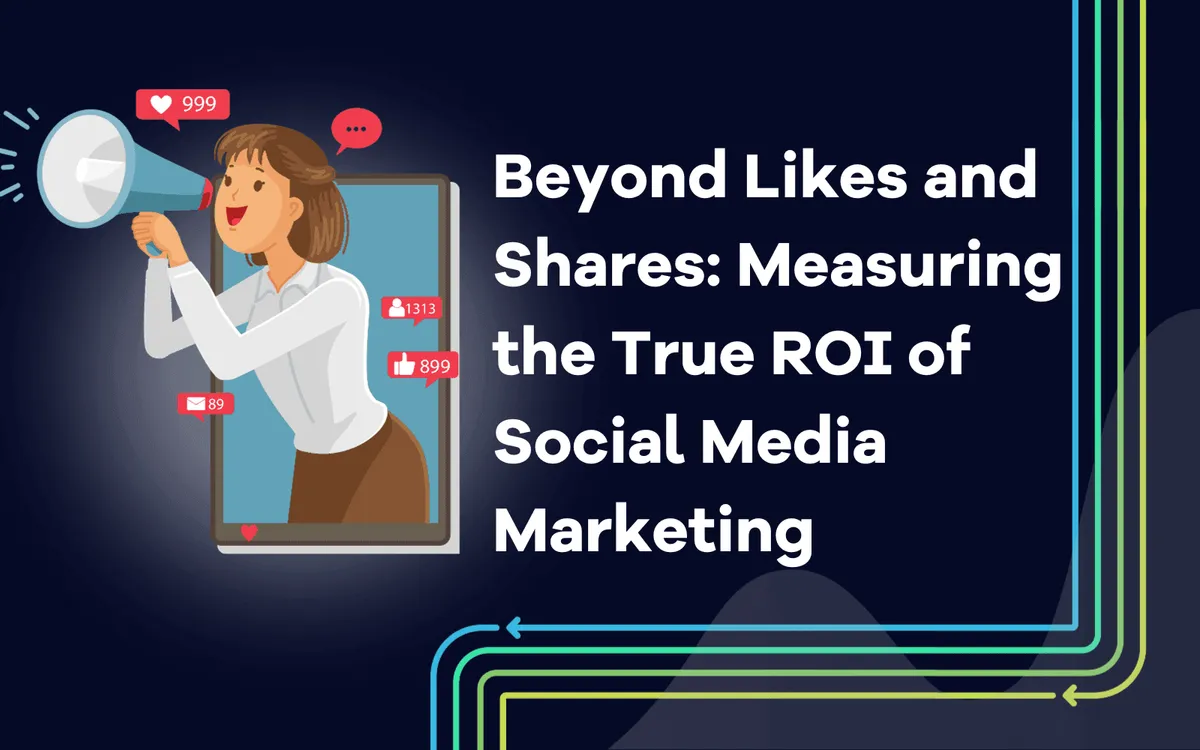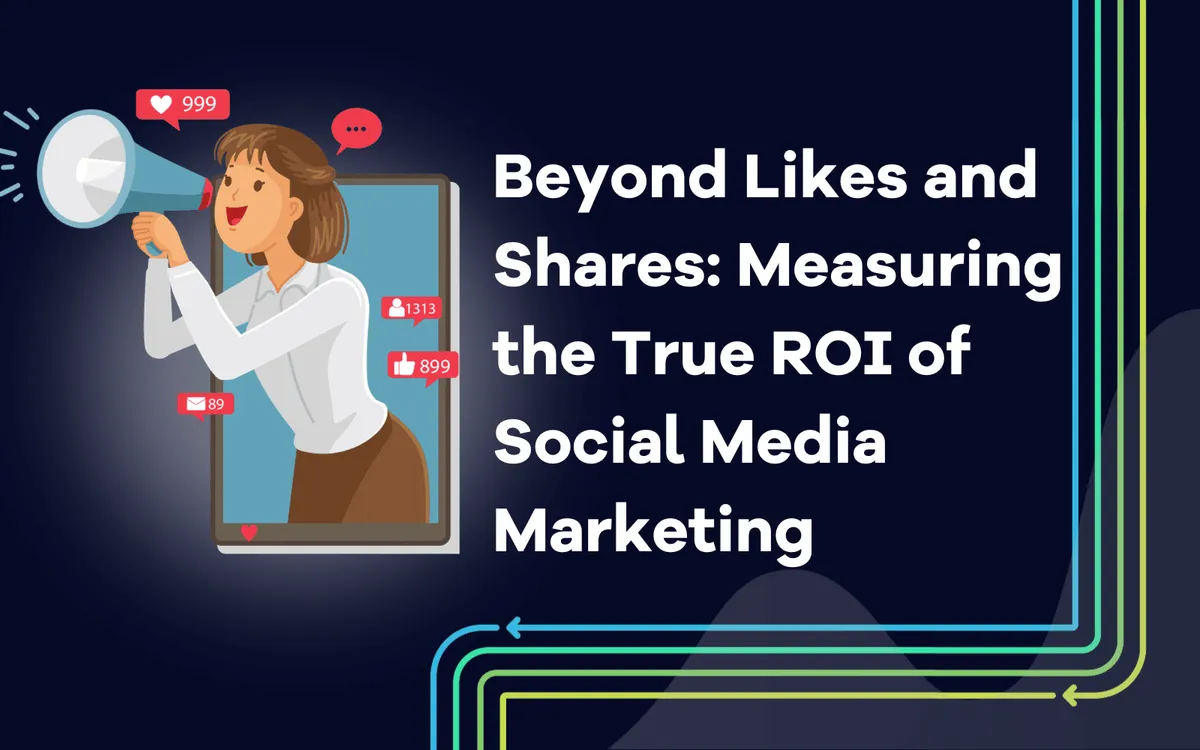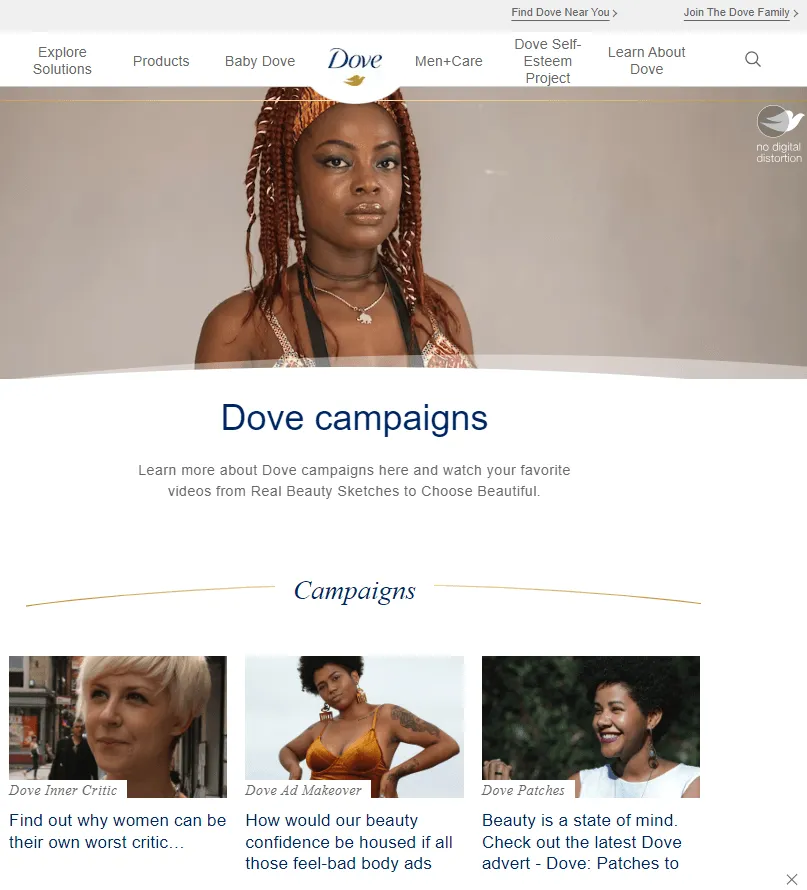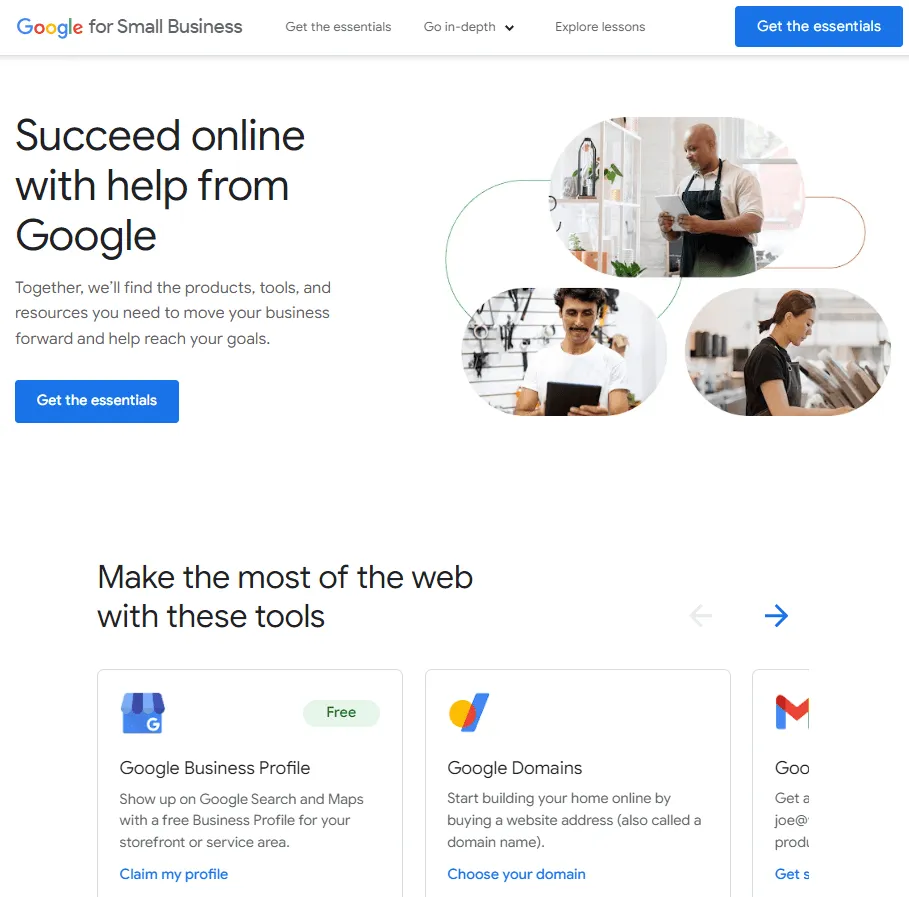
Beyond Likes and Shares: Measuring the True ROI of Social Media Marketing

Nayana Bhasurasen
October 27, 2023
Discover the secrets of social media marketing to measure real ROI. Move beyond likes and shares to make data-driven decisions that truly impact your business.

Businesses across the globe have recognized the power of platforms like Facebook, Instagram, Twitter, TikTok, and LinkedIn to connect with their target audiences, build brand awareness, and foster customer engagement. Amidst the countless likes, shares, and retweets, the true ROI of social media marketing goes beyond likes and shares.
In this article, we explore the shifting landscape of social media ROI measurement and how businesses can measure the genuine impact of their social media efforts.
Let’s get started!
Defining True ROI in Social Media Marketing
ROI is a fundamental metric in marketing that quantifies the profitability of an investment relative to its cost. In social media marketing, ROI goes beyond monetary gains and encompasses the broader benefits and value generated from your online presence. It's essential to recognize that ROI can be measured in various ways, and not all returns are immediately monetary.
Tangible Returns
Tangible returns are quantifiable and directly measurable in monetary terms. They include:
Monetary Gain: The most straightforward measure of ROI in social media marketing is the actual monetary profit generated from your social media efforts. This includes revenue directly attributed to social media campaigns, such as sales from referral links or e-commerce transactions.
Cost Savings: Social media can also lead to cost savings, such as reduced customer service costs. Businesses can lower the need for dedicated support staff if they use social media to address customer inquiries and issues.
Lead Generation: Tangible returns can also come in the form of leads and conversions. Track how many leads or potential customers were generated through your social media channels and calculate the conversion rate to assess the ROI.
Customer Lifetime Value (CLV): Evaluating the CLV of customers acquired through social media can provide insights into the long-term profitability of your social media efforts.
Intangible Returns
Intangible returns are qualitative and challenging to measure in monetary value, but they hold significant value for brand growth and perception:
Brand Awareness
Social media plays a crucial role in building and enhancing brand awareness. While it may be challenging to directly quantify its impact on revenue, you can measure brand sentiment, reach, and mentions as indicators of brand awareness.
Customer Loyalty
Social media can foster customer loyalty and retention. Assess customer engagement, satisfaction, and feedback as proxies for the intangible ROI gained through improved customer relationships.
Influencer Relationships
If you collaborate with influencers, consider the value of these relationships. The exposure and credibility they bring to your brand can be challenging to quantify precisely but contribute to your social media ROI.
Content Engagement
Measure the engagement with your content, such as likes, shares, comments, and clicks. High engagement indicates that your content is resonating with your audience, even if it doesn't immediately translate into revenue.
Identifying KPIs for True ROI
Identifying key performance indicators (KPIs) that accurately measure these benefits is crucial for assessing the true ROI.
Reach and Impressions:
Reach: The number of unique users exposed to your social media content.
Impressions: The total number of times your content is displayed.
Engagement Rates:
Likes, Comments, Shares: Metrics that measure user engagement and interaction with your content.
Click-through Rate (CTR): Percentage of users who clicked on a link or call to action in your posts.
Conversion Metrics:
Conversion Rate: Percentage of users who completed a desired action (e.g., making a purchase) after interacting with your social media content.
Lead Generation: Number of leads captured through social media campaigns.
Customer Sentiment:
Sentiment Analysis: Analyzing mentions and comments to gauge the overall sentiment (positive, negative, neutral) towards your brand.
Customer Retention and Loyalty:
Churn Rate: Percentage of customers who stopped using your product or service.
Customer Lifetime Value (CLV): Predicting the total revenue a business can expect from a customer during their entire engagement.
Social Media Traffic:
Website Traffic: Measuring the number of users referred to your website from social media platforms.
Cost Metrics:
Cost per Click (CPC): Calculating the cost of each click generated through paid social media advertising.
Cost per Acquisition (CPA): Calculating the cost to acquire a new customer through social media campaigns.
Tools and Technologies for Measuring True ROI
Check out some tools and technologies that can help you measure true ROI effectively:
Advanced Analytics Platforms
These platforms serve as the backbone for measuring ROI comprehensively. These platforms enable organizations to collect, analyze, and interpret data from various sources, offering insights into the performance of marketing campaigns, product launches, and other business initiatives.
Examples of advanced analytics platforms include Google Analytics, Adobe Analytics, and IBM Watson Analytics. These tools provide features like data visualization, predictive analytics, and cohort analysis, allowing businesses to assess the effectiveness of their investments accurately.
Utilizing Data Analytics and Machine Learning
Leveraging data analytics and machine learning algorithms to analyze complex datasets.
Identifying patterns, trends, and correlations in the data that impact ROI.
Predictive modeling for forecasting future ROI based on historical data.
Customizing Dashboards for Specific KPIs
Creating customized dashboards that cater to the specific Key Performance Indicators (KPIs) of your nonprofit or business.
Real-time visualization of KPIs for quick insights and decision-making.
Allowing stakeholders to monitor the metrics that directly affect ROI.
Social Media Monitoring Tools
These tools allow companies to track mentions, sentiment, and engagement metrics across social media channels. They help in quantifying the impact of social media efforts on ROI.
Examples of social media monitoring tools include Hootsuite, Sprout Social, and Brandwatch. These tools not only help in assessing ROI but also aid in identifying trends, monitoring competitors, and improving customer satisfaction through real-time insights.
Tracking brand mentions and sentiment
Monitoring social media platforms for mentions of your brand or products.
Analyzing sentiment (positive, negative, neutral) associated with these mentions.
Identifying trends in sentiment to gauge how it impacts ROI.
Monitoring competitor activities
Tracking competitors' social media activities and campaigns.
Comparing your brand's performance with competitors in terms of engagement, reach, and ROI.
Gaining insights into competitor strategies to adapt and improve your own.
Successful Campaigns with Measurable ROI
Apple - "Shot on iPhone" Campaign
This campaign showcases the exceptional photography capabilities of their iPhones through user-generated content. The intangible return of this campaign was a significant enhancement of brand image and customer loyalty. By leveraging user-generated content, Apple built a community of brand advocates, fostering a sense of trust and loyalty among its customers.
Measuring the ROI involved monitoring social media engagement, user-generated content submissions, and conducting customer surveys. Positive sentiment, higher social media shares, increased brand affinity, and customer retention were crucial indicators of the campaign's success.

Source: Apple
Patagonia - "Action Works" Campaign
This Patagonia campaign focuses on environmental activism and community engagement. The intangible return on investment was reinforcing the brand's commitment to environmental sustainability and rallying a community of like-minded individuals.
Patagonia tracked the number of users who engaged with their Action Works platform, signed petitions, or participated in environmental events. They also monitored media coverage and assessed how the campaign influenced public perception of the brand as an environmental advocate.

Source: Patagonia
Dove - "Real Beauty" Campaign
It aimed to promote body positivity and challenge beauty stereotypes. The intangible return on investment was strengthening Dove's brand image as a champion of real beauty and female empowerment.
To measure ROI, Dove conducted in-depth interviews and surveys with campaign participants, analyzing their perceptions of beauty and self-esteem before and after engaging with the campaign. They also tracked social media engagement, particularly shares, comments, and user-generated content, to gauge the campaign's impact on a broader audience.

Source: Dove
Google - "Google Small Business Boost" Campaign:
It aimed to support small businesses through various tools and resources. The intangible return was enhancing brand loyalty and positioning Google as a partner in business success. To measure ROI, Google utilized a combination of website analytics, tracking how many businesses engaged with their tools and resources. Additionally, they conducted surveys to assess the impact of the campaign on small business owners, including changes in perception and utilization of Google's services.

Source: Google
Challenges in Measuring True ROI
Measuring the true return on investment (ROI) can be challenging due to various factors and complexities involved in assessing the impact of an investment accurately. Here are some challenges in measuring the true ROI:
Attribution and Causality
Identifying the specific impact of a particular investment on overall business outcomes can be difficult. Many factors may contribute to an outcome, and it's often challenging to establish a clear cause-and-effect relationship. For example, if a marketing campaign leads to increased sales, it can be challenging to determine how much of that increase can be attributed solely to the campaign, as other variables may also be at play.
Time Lag
ROI calculations often require tracking and analyzing results over an extended period. Investments may take time to generate returns, and the effects of an investment may not become apparent immediately. This time lag can complicate ROI measurement, especially for long-term investments or projects.
Data Quality and Availability
Accurate ROI calculations rely on reliable data. Gathering, analyzing, and validating data can be challenging, especially if the data sources are disparate, incomplete, or of poor quality. Inaccurate or incomplete data can lead to flawed ROI assessments.
Intangible Benefits and Costs
Some investments yield intangible benefits or incur intangible costs that are difficult to quantify. For example, investments in employee training may lead to improved morale and employee retention, which can have long-term benefits but are challenging to quantify in monetary terms. Similarly, some costs, such as the impact on brand reputation from a negative event, can be challenging to measure accurately.
Future of Social Media ROI Measurement
Predictive Analytics and AI-driven Insights
These technologies will play a crucial role in measuring social media ROI. It will help businesses forecast future performance based on historical data, allowing for more proactive decision-making.
The use of AI content generators will become increasingly significant in creating and distributing engaging content across these emerging platforms, further influencing social media ROI.
AI can analyze vast amounts of social media data to identify trends, patterns, and correlations that humans might miss. This can lead to more accurate predictions about which social media strategies are likely to yield the best results.
Role of Emerging Social Media Platforms
Emerging social media platforms will present both opportunities and challenges in measuring ROI. As new platforms gain popularity, businesses will need to assess which ones are relevant to their target audience and align with their brand.
Tracking ROI on these platforms may require adapting measurement strategies to account for unique features and user behaviors. For example, ephemeral content on platforms like TikTok and Instagram Stories may require different KPIs compared to traditional social media posts.
Adapting to Changing Consumer Behaviors and Expectations
As consumer behavior and expectations change, so will the metrics for measuring ROI. For example, consumers are increasingly valuing authenticity and social responsibility in brands, so metrics related to engagement and sentiment analysis may become more important.
Businesses will need to continually adjust their social media strategies and ROI measurement frameworks to align with evolving consumer preferences.
Conclusion
The true ROI of social media marketing lies in a comprehensive understanding of how social media platforms influence brand perception, customer engagement, and ultimately, the bottom line. As we move forward, it is clear that success in the digital age will be defined not only by the number of interactions but by the quality and impact they create, underscoring the imperative to go beyond likes and shares in our pursuit of social media marketing excellence.
Related blog posts
The Hidden Flaws in Search Volumes and How to Solve Them
Learn how AI Search Volume delivers reliable search volumes by combining GKP, GSC, and Trends so that you can prioritize the right keywords.
1 July 2025
AI Overviews Are Taking Over SERPs
From traffic drops to decreasing CTRs, AI Overviews are shaking up SEO. Learn what is happening and how AccuRanker helps you track AIO.
25 June 2025
How AccuRanker’s AI Models Fix Inaccurate SEO Data
Struggling with unreliable SEO data? Discover how AccuRanker’s CTR, Search Intent, Search Volume, and Share of Voice deliver accurate insights.
1 June 2025




